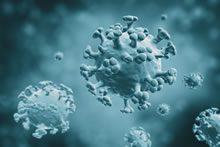
"Original antigenic sin" means the immune system is gearing its responses to a previously encountered viral strain rather than the current infecting strain.
Scientists studying flu vaccines have identified ways to overcome an obstacle called "original antigenic sin," which can impair immune responses to new flu strains.
Original antigenic sin (OAS) is a situation where the immune system is fighting with obsolete weapons and has trouble adapting. After encountering one viral strain, and then a new one that is related to the first, the immune system can respond by making antibodies against the first strain, resulting in a less effective defense.
Researchers at Emory Vaccine Center have demonstrated in experiments with mice that OAS can be overcome by using a vaccine additive called an adjuvant, or by repeated immunization with the second viral strain. The results were published this week in Proceedings of the National Academy of Sciences (PNAS).
The first author of the paper is postdoctoral fellow Jin Hyang Kim, who now works on influenza at the Centers for Disease Control and Prevention. The senior author is Joshy Jacob, associate professor of microbiology and immunology at Emory University School of Medicine.
The findings could be important when vaccinating individuals with weaker immune systems, such as people with chronic infections, small children or the elderly, the authors write.
The influenza virus has become so widespread because it can infect a wide range of hosts such as pigs and birds, and because its genome is flexible, Jacob says.
Influenza strains change their genes* in two ways. Antigenic drift occurs as a strain accumulates small mutations, which can help it escape from the host's immune system. Antigenic shift occurs when two strains, possibly from different host species, swap genetic material.*
"Original antigenic sin is really a reflection of the agility of the influenza virus," he says. "OAS becomes a factor when the new circulating strain is a 'drifted' version of what came before. The old antibodies can't neutralize the new virus, and that helps the new virus survive."
In a Journal of Immunology paper published in 2009, Jin and Jacob showed that OAS could impair the immune responses of mice exposed to two well-studied H1N1 flu strains: PR8, from 1934, and FM1, from 1947.
If mice are immunized first with inactivated PR8 virus and a month later FM1, and then exposed to live FM1, the lungs of the mice had higher viral levels than those that weren't immunized first with PR8. This effect was even stronger after sublethal infection with live virus, rather than vaccination with inactivated virus.
In the new PNAS paper, Jin and colleagues demonstrated that combining the FM1 immunization with an adjuvant allows the mice to respond better to the live virus. The adjuvant is a squalene oil-in-water emulsion. Squalene is a vaccine additive licensed in European countries since the 1990s, but not approved for use in the United States. Surprisingly, the adjuvant could also improve immune responses when combined with the initial PR8 immunization.
"It appears that the adjuvant is making the immune responses to the first viral strain broader, so that a wider range of antibody-producing cells are able to respond to the second strain," Jacob says.
The handicap of the twice-immunized mice against the second virus could also be overcome by a booster shot against the second virus. The authors write:
"Collectively, our findings imply that OAS could potentially be prevented in the naïve human population, especially children, by administering adjuvants with the first influenza vaccine. Alternatively, in the older population with prior influenza virus exposure or vaccinations, original antigenic sin can be minimized by using adjuvants."
The research was supported by the National Institute of Allergy and Infectious Diseases (HHSN266 200700006C). Jacob's laboratory is part of the Influenza Pathogenesis & Immunology Research Center at Emory and University of Georgia, one of five Centers of Excellence for Influenza Research and Surveillance supported by NIAID.
Reference: J.H. Kim, W.G. Davis, S. Sambhara and J. Jacob. Strategies to alleviate original antigenic sin responses to influenza viruses. PNAS (2012).
doi: 10.1073/pnas.0912458109
*Influenza is an RNA virus and replicates via a RNA-dependent RNA polymerase.
